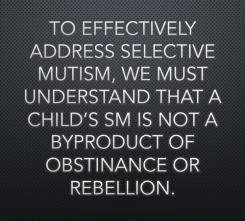The fourth installment in Myth Management– a series addressing misconceptions that surround children struggling with Selective Mutism and Social Phobia
To read from the beginning of the series: click here
BY: RACHEL LOWE, ATS INTERN 2017
 “When will you pick me up after school?” Ben asks his mother as she drops him off at kindergarten. Ben and his mother converse for a minute or two about the day ahead as he makes his way out of the car. The mother gives her son a hug and leaves.
“When will you pick me up after school?” Ben asks his mother as she drops him off at kindergarten. Ben and his mother converse for a minute or two about the day ahead as he makes his way out of the car. The mother gives her son a hug and leaves.
Ben’s teacher stands in the doorway, observing the interaction with curiosity. Given that Ben has not spoken a single word in the classroom, his ability to converse normally with his mother perplexes her. Why does Ben speak to his mother, but refuse to speak to me after six months of kindergarten? she wonders.
Later that day, the teacher supervises recess and continues to observe Ben as he runs around the playground. She watches with bewilderment as Ben sneaks up behind a friend, yelling “BOO!” and giggling at his friend’s surprise.
The teacher has realized by now that Ben has the ability to speak, and that he does so with ease around his mother and friend. The teacher concludes that his failure to speak in the class setting can only be attributed to his own defiance. He’s choosing not to speak in school, she thinks. Growing impatient, the teacher decides that she will crack down on his stubborn behavior. She will no longer accept it when Ben opts for silence when she addresses him.
This scenario illustrates a common myth of selective mutism (SM): children with SM willfully choose not to speak. Many mistakenly believe that this “choice” stems from obstinance, or perhaps even a streak of rebelliousness on the part of the child. In this fourth installment of Myth Management, we hope to unravel the “obstinance myth” of SM and examine the factors that have led to this belief. Simply, selective mutism—the inability to speak in certain social settings, like the classroom, despite the ability to speak normally in other settings, like home—is not related to defiance. Children do not choose to be selectively mute; rather, a child’s mutism is rooted in anxiety.
Though the exact cause of selective mutism is unknown, some research provides evidence for “a genetic link between children with SM and anxious parents or family members,” according to the Selective Mutism Association. For anxious individuals, the amygdala (an area of the brain that processes emotions, like fear) overestimates how threatening a situation actually is. Although there is no rational danger involved in speaking in the classroom setting, for example, “the feelings that the child with SM experiences are just as real as if an actual threat or danger were present.” A child struggling with SM may desperately wish to speak—to peers, strangers, or that teacher at school—but is unable to do so when confronted with immobilizing feelings of anxiety.
Take Ben, for example, who does not speak to his teacher or peers in the classroom. What makes his mutism so enigmatic to his teacher is that he appears relatively relaxed in the school environment. If he seems so comfortable, why doesn’t he speak when she asks him a question? For those unfamiliar with SM, it’s difficult to understand that his mutism behavior results from anxiety; it seems more logical to attribute his silence to a behavioral issue like defiance. As a result, teachers and classmates may incorrectly label the child as stubborn, manipulative, or controlling. Especially for SM children who are also struggling with social phobia, an intense fear of negative judgment by others, these harmful assumptions will only exacerbate anxiety and thus reinforce the mutism.
Children with selective mutism often do not display the telltale physical signs of anxiety (e.g. shaking, sweating, tense body language). Despite a child’s internal discomfort, an onlooker may observe that the child appears quiet, motionless, and devoid of facial expression. These behaviors do not reveal a child’s stubbornness, but rather reflect an effort to control anxiety. Further complicating the issue is the fact that once people in a child’s environment learn that s/he is not speaking, they may pull for nonverbal communication instead, placing the child at ease since the expectation to speak is removed. Therefore, the child may look relaxed in an environment that has learned and adopted alternative ways to communicate with him/her. Of course, every case of SM is unique. Physical symptoms of anxiety may be nonexistent for some, but glaring for others. And for some, physical clues of anxiety will be visible, but subtle.
 To effectively address selective mutism, we must understand that a child’s SM is not a byproduct of obstinance or rebellion. If parents and teachers view this silence through the “obstinance lens,” they may discipline or berate the child, or wait for the child to grow out of the stubbornness. Without necessary treatment, a child’s mutism will likely persist. Further, disciplining a child for his/her selective mutism will only generate confusion and pain. When we understand that a child’s selective mutism has its roots in anxiety, a pathway to treatment becomes more clear. The active approach of “Let’s seek treatment for my son’s selective mutism” and “What steps can we take to move from not speaking to speaking in the school setting?” replaces the passive, ineffective approach of “He’ll grow out of it.” With greater understanding, families and educators can more effectively and productively address selective mutism.
To effectively address selective mutism, we must understand that a child’s SM is not a byproduct of obstinance or rebellion. If parents and teachers view this silence through the “obstinance lens,” they may discipline or berate the child, or wait for the child to grow out of the stubbornness. Without necessary treatment, a child’s mutism will likely persist. Further, disciplining a child for his/her selective mutism will only generate confusion and pain. When we understand that a child’s selective mutism has its roots in anxiety, a pathway to treatment becomes more clear. The active approach of “Let’s seek treatment for my son’s selective mutism” and “What steps can we take to move from not speaking to speaking in the school setting?” replaces the passive, ineffective approach of “He’ll grow out of it.” With greater understanding, families and educators can more effectively and productively address selective mutism.
Educate yourself and join in fighting the myth by clicking here and learning more about selective mutism and its treatment options.
